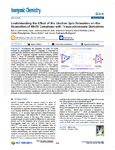Mostrar o rexistro simple do ítem
Understanding the Effect of the Electron Spin Relaxation on the Relaxivities of Mn(II) Complexes with Triazacyclononane Derivatives
| dc.contributor.author | Uzal-Varela, Rocío | |
| dc.contributor.author | Valencia, Laura | |
| dc.contributor.author | Lalli, Daniela | |
| dc.contributor.author | Maneiro, Marcelino | |
| dc.contributor.author | Esteban-Gómez, David | |
| dc.contributor.author | Platas-Iglesias, Carlos | |
| dc.contributor.author | Botta, Mauro | |
| dc.contributor.author | Rodríguez-Rodríguez, Aurora | |
| dc.date.accessioned | 2022-03-08T13:25:37Z | |
| dc.date.available | 2022-03-08T13:25:37Z | |
| dc.date.issued | 2021-10-07 | |
| dc.identifier.citation | Uzal-Varela, R.; Valencia, L.; Lalli, D.; Maneiro, M.; Esteban-Gómez, D.; Platas-Iglesias, C.; Botta, M.; Rodríguez-Rodríguez, A. Understanding the Effect of the Electron Spin Relaxation on the Relaxivities of Mn(II) Complexes with Triazacyclononane Derivatives. Inorg. Chem. 2021, 60, 15055-15068. | es_ES |
| dc.identifier.issn | 0020-1669 | |
| dc.identifier.issn | 1520-510X | |
| dc.identifier.uri | http://hdl.handle.net/2183/29906 | |
| dc.description.abstract | [Abstract] Investigating the relaxation of water ¹H nuclei induced by paramagnetic Mn(II) complexes is important to understand the mechanisms that control the efficiency of contrast agents used in diagnostic magnetic resonance imaging (MRI). Herein, a series of potentially hexadentate triazacyclononane (TACN) derivatives containing different pendant arms were designed to explore the relaxation of the electron spin in the corresponding Mn(II) complexes by using a combination of ¹H NMR relaxometry and theoretical calculations. These ligands include 1,4,7-triazacyclononane-1,4,7-triacetic acid (H₃NOTA) and three derivatives in which an acetate group is replaced by sulfonamide (H₃NOƨASAm), amide (H₂NOƨAM), or pyridyl (H₂NOƨAPy) pendants. The analogue of H₃NOTA containing three propionate pendant arms (H₃NOTPrA) was also investigated. The X-ray structure of the derivative containing two acetate groups and a sulfonamide pendant arm [Mn(NOƨASAm)]⁻ evidenced six-coordination of the ligand to the metal ion, with the coordination polyhedron being close to a trigonal prism. The relaxivities of all complexes at 20 MHz and 25 °C (1.1–1.3 mM⁻¹ s⁻¹) are typical of systems that lack water molecules coordinated to the metal ion. The nuclear magnetic relaxation profiles evidence significant differences in the relaxivities of the complexes at low fields (<1 MHz), which are associated with different spin relaxation rates. The zero field splitting (ZFS) parameters calculated by using DFT and CASSCF methods show that electronic relaxation is relatively insensitive to the nature of the donor atoms. However, the twist angle of the two tripodal faces that delineate the coordination polyhedron, defined by the N atoms of the TACN unit (lower face) and the donor atoms of the pendant arms (upper face), has an important effect in the ZFS parameters. A twist angle close to the ideal value for an octahedral coordination (60°), such as that in [Mn(NOTPrA)]⁻, leads to a small ZFS energy, whereas this value increases as the coordination polyhedron approaches to a trigonal prism. | es_ES |
| dc.description.sponsorship | C.P.-I., D.E.-G., and A.R.-R. thank Ministerio de Ciencia e Innovación (Grants CTQ2016-76756-P and PID2019-108352RJ-I00) and Xunta de Galicia (Grants ED431B 2017/59 and ED431D 2017/01) for generous financial support. R.U.-V. thanks Xunta de Galicia (Grant ED481A-2018/314) for funding her PhD contract | es_ES |
| dc.description.sponsorship | Xunta de Galicia; ED431B 2017/59 | es_ES |
| dc.description.sponsorship | Xunta de Galicia; ED431D 2017/01 | es_ES |
| dc.description.sponsorship | Xunta de Galicia; ED481A-2018/314 | es_ES |
| dc.language.iso | eng | es_ES |
| dc.publisher | American Chemical Society | es_ES |
| dc.relation | info:eu-repo/grantAgreement/AEI/Plan Estatal de Investigación Científica y Técnica y de Innovación 2013-2016/CTQ2016-76756-P/ES/NUEVA GENERACION DE AGENTES DE CONTRASTE PARA IMAGEN POR RESONANCIA MAGNETICA (IRM) ALTERNATIVOS A LOS DERIVADOS DE GADOLINIO/ | |
| dc.relation | info:eu-repo/grantAgreement/AEI/Plan Estatal de Investigación Científica y Técnica y de Innovación 2017-2020/PID2019-108352RJ-I00/ES/AGENTES DE CONTRASTE PARA IRM BASADOS EN HIERRO(III) PARA LA DETECCION DE CANCER DE MAMA/ | |
| dc.relation.uri | https://doi.org/10.1021/acs.inorgchem.1c02057 | es_ES |
| dc.rights | Atribución 4.0 Internacional | es_ES |
| dc.rights.uri | http://creativecommons.org/licenses/by/4.0/ | * |
| dc.title | Understanding the Effect of the Electron Spin Relaxation on the Relaxivities of Mn(II) Complexes with Triazacyclononane Derivatives | es_ES |
| dc.type | info:eu-repo/semantics/article | es_ES |
| dc.rights.access | info:eu-repo/semantics/openAccess | es_ES |
| UDC.journalTitle | Inorganic Chemistry | es_ES |
| UDC.volume | 60 | es_ES |
| UDC.issue | 20 | es_ES |
| UDC.startPage | 15055 | es_ES |
| UDC.endPage | 15068 | es_ES |
Ficheiros no ítem
Este ítem aparece na(s) seguinte(s) colección(s)
-
GI-REACT! - Artigos [103]






